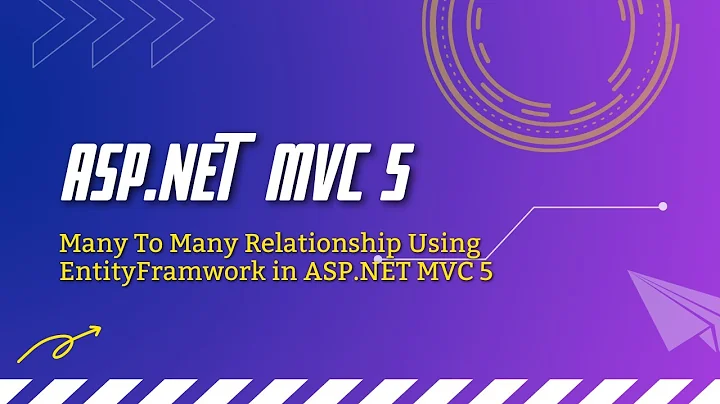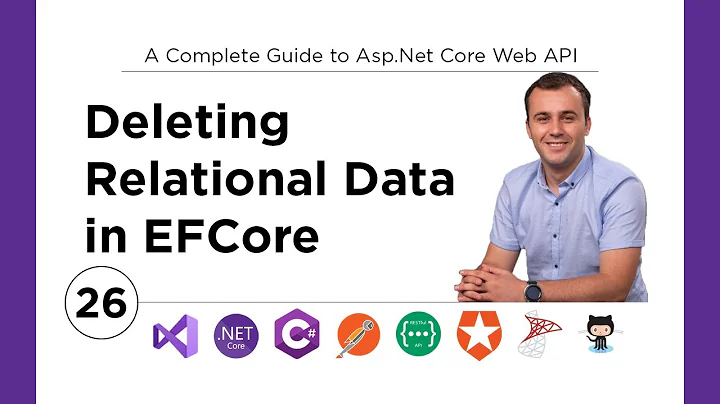Entity Framework proper way to replace collection in one to many
Solution 1
I had the exact same question :)
This answer on identifying relationships solved my issue.
Note: You have to load the collection (eagerly, explicitly or lazily) so that it can be tracked before setting the new values and calling save. Otherwise you will not be replacing the collection but, just be adding to it.
For example:
var entity = unitOfWork.EntityRepository.GetById(model.Id);
// I have something like this to load collection because
// I don't have the collection's entities exposed to the context
unitOfWork.EntityRepository.LoadCollection(entity, e => e.CollectionProperty);
entity.CollectionProperty = newCollectionValuesList;
unitOfWork.Save();
This will remove the previous collection values from the 'collection table' and only add the newly set values.
Hope that helps.
Solution 2
First (optional):
I recommend you to make
public ICollection<PhoneNumber> phones {get; private set;}
a virtual property, to let the Entity Framework know that it should be lazy loaded (even if you do not have Lazy Load enabled, it is a good practice).
public virtual ICollection<PhoneNumber> phones {get; private set;}
Second:
Add an Inverse Navigation Property on your PhoneNumber class (it will be required in order to achieve the solution I give you below):
public class PhoneNumber : IValueObject {
public string Number {get; set;}
public string Type {get; set;}
public virtual Customer {get; set;}
}
public class Customer : IEntity {
public ICollection<PhoneNumber> phones {get; private set;} //ew at no encapsulated collection support
public void SetPhones(params PhoneNumber[] phones) {
this.phones.Clear();
this.phones.AddRange(phones);
}
}
Third (Possible solution for your problem):
Remove the PhoneNumber objects from Context instead of doing so from the Customer:
public ICollection<PhoneNumber> phones {get; private set;} //ew at no encapsulated collection support
public void SetPhones(params PhoneNumber[] phones) {
Context.PhoneNumbers.RemoveRange(this.phones);
this.phones.AddRange(phones);
}
}
Related videos on Youtube
Abhishek
I have been a senior developer with a focus on architecture, simplicity, and building effective teams for over ten years. As a director at Surge consulting I was involved in many operational duties and decisions and - in addition to software development duties - designed and implemented an interview processes and was involved in community building that saw it grow from 20 to about 350 developers and through an acquisition. I was then CTO setting up a dev shop at working closely with graduates of a coding bootcamp on both project work and helping them establish careers in the industry. Currently a Director of Engineering at findhelp.org your search engine for finding social services. I speak at conferences, have mentored dozens of software devs, have written popular articles, and been interviewed for a variety of podcasts and publications. I suppose that makes me an industry leader. I'm particularly interesting in companies that allow remote work and can check one or more of the following boxes: Product companies that help people in a non-trite manner (eg I'm not super interested in the next greatest way to get food delivered) Product companies that make developer or productivity tooling Funded startups that need a technical co-founder Functional programming (especially Clojure or Elixir) Companies trying to do something interesting with WebAssembly
Updated on July 13, 2022Comments
-
 Abhishek almost 2 years
Abhishek almost 2 yearsSuppose a customer has many phone numbers and a phone number has only one customer.
public class PhoneNumber : IValueObject { public string Number {get; set;} public string Type {get; set;} } public class Customer : IEntity { public ICollection<PhoneNumber> phones {get; private set;} //ew at no encapsulated collection support public void SetPhones(params PhoneNumber[] phones) { this.phones.Clear(); this.phones.AddRange(phones); } }If I do an EF mapping like this and run it, every time I set phone numbers it will create new PhoneNumbers but not delete the old ones. There are no other entities referencing phone numbers, I don't even expose it on my dbcontext, is there a way to tell EF that
CustomerownsPhoneNumberscompletely and therefore if phone numbers were removed from the collection they should be deleted?
I realize that there's a dozen ways to hack around this problem, but this isn't a weird edge case, what's the "right" way to handle this.
-
 Abhishek about 9 yearsError during
Abhishek about 9 yearsError duringUpdate-Database.An error occurred while saving entities that do not expose foreign key properties for their relationships. The EntityEntries property will return null because a single entity cannot be identified as the source of the exception. Handling of exceptions while saving can be made easier by exposing foreign key properties in your entity types...A relationship from the 'Customer_phones' AssociationSet is in the 'Deleted' state. Given multiplicity constraints, a corresponding 'Customer_phones_Target' must also in the 'Deleted' state. -
 Alexandre Severino about 9 years@GeorgeMauer try commenting the Third step and do only the first two. They should be enough to solve your problem.
Alexandre Severino about 9 years@GeorgeMauer try commenting the Third step and do only the first two. They should be enough to solve your problem. -
 Abhishek about 9 yearsRemoving the third step (even when I keep the
Abhishek about 9 yearsRemoving the third step (even when I keep thePhoneNumber->Customerrelationship) causes the issue in the screenshot above. Old phone numbers now just have a null customer, they are not removed. -
 Alexandre Severino about 9 yearsAlso, instead of doing my new "third step" you could try adding
Alexandre Severino about 9 yearsAlso, instead of doing my new "third step" you could try adding[Required]right above thepublic virtual Customer {get; set;}or adding the propertypublic int CustomerId {get; set;}which signs EF that the Customer MUST NOT be null. -
 Alexandre Severino about 9 yearsPlease let me know if any of the new ideas on my comments work so I can edit the answer.
Alexandre Severino about 9 yearsPlease let me know if any of the new ideas on my comments work so I can edit the answer. -
 Abhishek about 9 yearsHave to run out now, will be back to it in a few hours
Abhishek about 9 yearsHave to run out now, will be back to it in a few hours -
 Abhishek about 9 yearsIn your update, where does
Abhishek about 9 yearsIn your update, where doesContextcome from? Wouldn't that mean that entities have to be connected to the db context? How on earth would you uni test that? -
 Alexandre Severino about 9 yearsNevermind my Third answer if you need a uni test... have you tried the
Alexandre Severino about 9 yearsNevermind my Third answer if you need a uni test... have you tried the[Required]and adding theCustomerIdproperty instead? -
 Abhishek about 9 yearsI have but the core issue is that this doesn't tell Entity Framework that
Abhishek about 9 yearsI have but the core issue is that this doesn't tell Entity Framework thatPhoneNumberis not used by a different class. So required or not, how would it know that it is ok to delete this? -
 Alexandre Severino about 9 yearsEF knows that your
Alexandre Severino about 9 yearsEF knows that yourPhoneNumberis not being used anywhere else than inCostumer. Thus, if theRequiredis set on PhoneNumber'sCustomerinverse property and this veryCustomerceases to exist,PhoneNumbershould be automatically cascade deleted. -
 Abhishek almost 9 years+1 for actually doing things correctly and having repositories flow "out of" a unit of work. I still don't really get the answer though. What would
Abhishek almost 9 years+1 for actually doing things correctly and having repositories flow "out of" a unit of work. I still don't really get the answer though. What wouldEntitylook like here? Are you saying that this trick with phone number ids alone is enough to get it to trigger a delete properly? -
Quinton Smith almost 9 years@GeorgeMauer - Entity here would be your
CustomerandCollectionPropertywould be yourphonesproperty. In my case I'm loading my collections explicitly soLoadCollectionlooks likecontext.Entry(entity).Collection(navigationProperty).Load();under the hood. If you have an identifying relationship between Customer and PhoneNumber and you have loadedphonesfor a customer then the code in your screenshot should leave you with only 123-456-7890 in the PhoneNumbers table. -
Kieran Ojakangas over 3 years@QuintonSmith is that "Save" method you have written out which is really eventually just calling "SaveChanges()?"
-
Quinton Smith over 3 years@KieranOjakangas you are exactly right. Under the hood it's simply
context.SaveChanges(); -
Rex almost 3 yearsThank you very much @QuintonSmith, you saved my day with your comment that child collections need to be loaded to be replaced.










